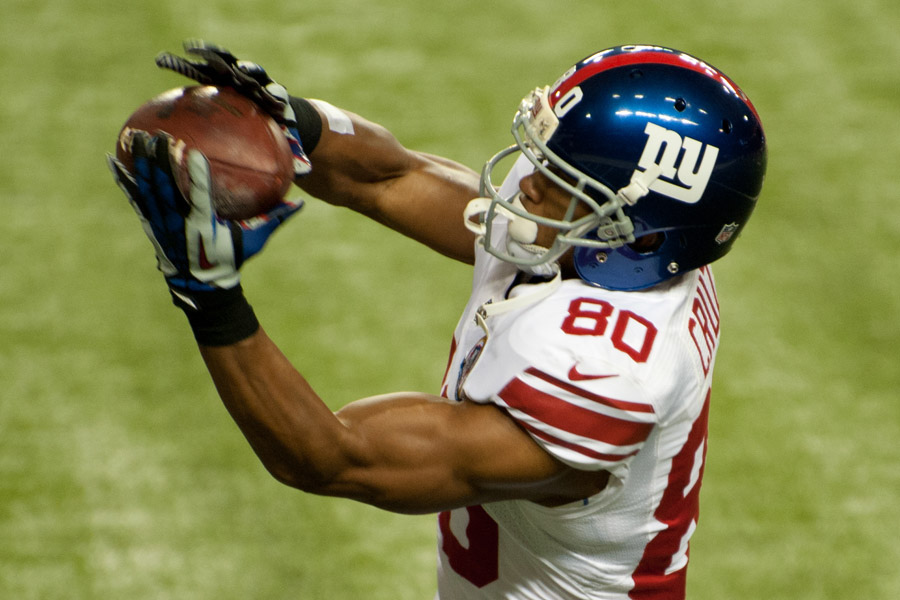
What if I told you Keenan Davis is a safer pick than Tavon Austin? I know, I can’t even say it with a straight face. Although an attention-getting joke, don’t laugh off Davis’ game. The 6’2″, 216-pound Iowa receiver is a skillful player whose game fits with a greater variety of NFL offensive styles than the West Virginia hybrid.
Austin is a scheme-dependent player at this stage of the NFL’s evolutionary cycle. This is not a knock on his skills as it is a statement about smaller players with diverse skill sets. At this point, an NFL team will have to use him from the slot or the backfield to maximize his statistical upside. I think it is unlikely that Austin has the physical dimensions to become a full-time outside receiver – the most important being a decent, but not fantastic vertical leap of 32 inches.
If Austin had Davis’ 38-inch vertical I’d be more inclined to say the West Virginia star has Steve Smith-like potential. Of course, no one is Steve Smith. If there was one guy I wanted to take for the RSPWP2 to pair with Carson Palmer it was the Carolina receiver. He’s nearing the final years of his career, but he’s as ferocious a receiver as I have seen play.
Davis is some ferocity to his game. Combine that with 4.48-speed (40-yard dash), and I think we’re looking at a player who not only can make an NFL team and contribute in four- or five-receiver sets early in his career, but he has the upside to develop into a starter on the outside.
Like Connecticut tight end Ryan Griffin, Davis is a good player in a draft class stocked with talent at his position who can thrive in most NFL systems because he plays a physical brand of football.
Over the Middle
[youtube http://www.youtube.com/watch?v=nGBVbPgaGgY&start=13rel=0&w=560&h=315]
On this 3rd-and-seven play against Pittsburgh, Davis is the outside receiver on the twin side of the formation working off press coverage to the middle of the field. Many receivers get distracted with contact on quick-hitting passes, but not Davis. The replay shows Davis using his outside arm to ward off the corner before turning to make a nice adjustment on a high throw in the middle of the field.
Best yet, Davis makes a money catch, taking a shoulder from a linebacker after he exposes his body to the interior defender and still hangs onto the ball. These are must-plays for offenses to sustain drives. They are also difficult plays to make, which is one of the reasons why spreading the field and going to smaller, quicker athletes is a trend – if you can’t find one of these tough guys you better find receivers defenders have difficulty laying a finger on.
On the Perimeter
[youtube http://www.youtube.com/watch?v=nGBVbPgaGgY&start=83rel=0&w=560&h=315]
What I like about this catch is that Davis doesn’t make his best leap towards the ball, which gives the cornerback a chance to play the ball. Although the defender misses his attempt to swat the pass, Davis still manages to snare the ball in traffic while airborne and falling towards the boundary. Focus is a consistent theme in Davis’ game and I value this from a receiver because tight coverage, impending hits, leaving one’s feet for the ball, or working routes near the boundary present a lot of distractions from the primary mission: catching the football.
A bonus is the hand strength to maintain possession despite the cornerback’s attempts to pry the ball loose on the way to the ground. There’s a toughness to Davis’ game that I think will earn him a roster spot and give him a chance to refine his game.
“Bad-Ball” Receiver
[youtube http://www.youtube.com/watch?v=nGBVbPgaGgY&start=213 rel=0&w=560&h=315]
The replay of his slant reveals how Davis has to reach to his back shoulder in tight coverage to make a play on the ball before taking another hit. This isn’t a dramatic adjustment, but I see wide receivers at every level drop this kind minor adjustment all the time.
Vertical Route
[youtube http://www.youtube.com/watch?v=6Gg22Y28AjQ&start=141rel=0&w=560&h=315]
This 2nd-and-26 go-route against single, press coverage is another nice example of Davis’ skill at adjusting to the ball while working off contact. Although I have seen Davis drop his share of passes after contact, there are generally two types of plays where this happens:
- High passes where the defender has position to knock the ball loose as Davis extends for the target (and generally bad ball location).
- Just after Davis makes the reception and he’s running down field without the ball secured to his body.
Play No.2 is better defined as a fumble and I predict if Davis doesn’t make a squad it will have to do with him continuing to display poor ball security (a product of effort you like to see, but not to the detriment of losing possession for the offense).
On this play, Davis manages to work outside the corner and maintain his balance after some hand fighting with the ball in the air to make a diving play with his back to the quarterback. As you see, focus and skill after contact is the line that connects these plays. Davis isn’t an exciting prospect compared to most of the receivers I have in my top 20 at the position, but he’s a workmanlike player whose quarterback wasn’t adept at pinpoint ball location.
If Davis shores up the ball security issues and continues to demonstrate skill after contact, he has a chance to become a good pro.
For analysis of skill players in this year’s draft class, download the 2013 Rookie Scouting Portfolio available April 1. Prepayment is available now. Better yet, if you’re a fantasy owner the 56-page Post-Draft Add-on comes with the 2013 RSP at no additional charge. Best, yet, 10 percent of every sale is donated to Darkness to Light to combat sexual abuse. You can purchase past editions of the Rookie Scouting Portfolio for just $9.95 apiece.




































